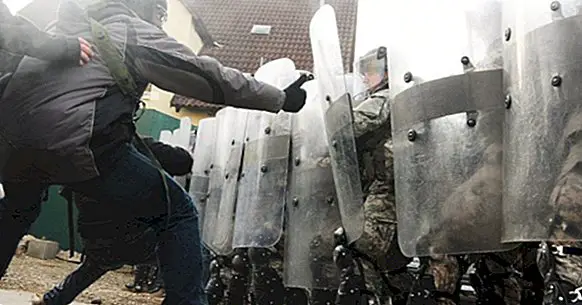The 18 types of aggression, and their effects
We have all witnessed some act of aggression. Be it in real life, on television or even through a novel, violence is an element that continues to be part of our society even today. But we often make the mistake of identifying aggression with physical attack.
Although obviously an act of intentional physical violence aimed at harming another is an aggression, we can also observe other types of acts that can be considered as such. We are talking about different types of aggression , of which we are going to talk throughout this article.
- Related article: "The neurological basis of aggressive behavior"
Aggression: understanding the basic concept
In order to understand the existence of differences between different types of aggression, it is necessary first to know what this concept refers to and what its implications are.
We understand aggression as all that act of violence characterized by causing intentional damage a person is said direct or indirect act. Although, as we have indicated before, it is traditionally associated with physical violence, aggression does not have to be limited to it or it is even possible that a physical element does not exist in the act of aggression.
The damages may be physical, psychological, sexual, patrimonial or symbolic, and may involve a series of serious effects on the health or integrity of the victim.
It is possible to find a large number of classifications in regards to the different types of aggression. Examples of this are according to their nature, objective or victim.
1. Types of aggression according to their nature
There are multiple ways to classify the different types of aggressions. One of the most common is that which takes into account the nature of the aggression. In turn, these can be classified into two large groups, although usually the categories are not totally mutually exclusive .
1.1. Direct aggression
Direct aggression refers to all that type of aggression that is perceptibly carried out for the aggressed person, whether it is physically or psychologically. This includes both the direct exercise of the aggression and the threat of carrying it out, requiring at least aggressor and attacked in that relationship. The victim is completely capable of identifying his aggressor . As of adolescence, it tends to be more frequent in males.
1.2. Physical aggression
Any act that involves the willful and intentional causation of direct damage generated through any physical means and with the capacity to generate bodily harm to the person attacked. The injuries caused can be temporary or permanent and appear both short and long term, with consequences that can even be deadly. Physical aggression tends to be more associated with the male sex.
1.3. Verbal / psychological aggression
It is understood as such to all that set of acts and actions that, although they do not generate a physical damage, they provoke or pretend to provoke in the person who suffers the aggression some kind of mental or emotional damage . It includes insults, humiliations and devaluations. In this sense, this type of direct violence tends to be more distributed among the sexes. Statistically, it is one of the most practiced by women.
1.4. Sexual aggression
Type of aggression in which the aggressor party forces or coerces the aggrieved party to maintain some type of sexual contact (whether or not there is penetration) or by depriving them of the freedom to decide. Includes both violations and touching , pushing or removing the condom without consent / knowledge of the fact. Although in recent years the female cases have increased, most of the sexual aggressors are male.
- Maybe you're interested: "The Sexual Assault Control Program: this is how this type of treatment works"
1.5. Indirect aggression
Indirect aggression is understood as any act of aggression that is carried out indirectly, causing damages to the aggressor anonymously (although this may recognize the aggressor). This type of attack is spreading more and more, and it is the most frequent in women as of adolescence, both at an academic and work level. Includes spreading rumors and slander , anonymous or publication of webs and humiliating and ridiculing messages.
1.6. Relational aggression
Indirect form of aggression based on the social exclusion caused by the aggrieved person, or in the causation of damage to your reputation through slander . It is usually verbal or psychological.
1.7. Cyber aggression
Although it can be included in some of the previous groups (both indirect and direct), cybernetic aggression has as its main distinguishing feature the fact that information and communication technologies are used for this purpose. Through it we can find attacks on social networks, identity theft, coercion, theft of accounts, defamatory publications, non-consensual recordings (including possible aggressions carried out with the victim), etc.
1.8. Patrimonial aggression
This type of aggression is based on the destruction or damage on the possessions of the aggrieved person. Its subtraction or usurpation can also be observed. It may or may not be aimed at generating damage to the attacked subject, especially if said possessions are of high emotional value or achieving them has been a great effort. In reality, it can be both indirect and direct (since destruction can occur covertly or not).
1.9. Symbolic aggression
Type of indirect aggression characterized by the fact that the attack is not made directly on the victim, but rather about elements that symbolize aspects linked to him or her such as religion, politics, sexual orientation or nationality.
2. According to your objective
In addition to the main aggressions mentioned above, we can also find other types of aggression depending on the objective pursued.
2.1. Hostile aggression
This type of aggression refers to all that action directed mainly to inflict some type of damage on a person, so that the damage is the main objective of the aggressor .
2.2. Instrumental aggression
On this occasion, the aggressive act is not intended to generate damage to the person assaulted, not being the suffering or discomfort of the other the intended , but that what motivates the attack is the obtaining of some type of gain or benefit of said attack. An example may be economic gain, social approval or the acquisition of a position of dominance and power.
2.3. Induced aggression
It is a type of aggressive act in which the aggressor acts moved by other people or by factors such as fear or the attempt to escape from some highly aversive situation.
3. Depending on the victim
Different types of aggression can also be observed depending on who the person to whom the act of violence is directed.
3.1. Self-inflicted aggression
It is called as such any act of aggression in which the victim of this is the same that causes the aggression. That is, it is an attack on oneself that can be motivated by a large number of causes. It can include self-injury caused by people with different pathologies or suicide.
3.2. Interpersonal aggression
It is the most classic and known type of aggression, in which one person inflicts damages and harm to another voluntarily.
3.3. Collective aggression
Type of aggression characterized by performing intergroup, attacking one group to another. The objective of the aggression It can be variable, in many cases there is hatred, stigmatization and attempts to eliminate the other group. In this type of aggression we could include events as serious as genocides.
4. According to the context in which it occurs
Another possible classification of the aggressions may come from the context in which they occur. In this sense, we can find ourselves among others with the following
4.1. Intrafamily and couple aggression
This type of interpersonal aggression can be separated from the rest by the fact that has the characteristic of occurring within the same family or between people who in principle maintain an affective bond. Domestic violence can take many forms, being mainly of a direct type, whether at the level of physical, psychological or even sexual aggression.
4.2. Aggression in the workplace
All that act of aggression produced in the context of work. We can include in this the presence of physical, verbal or even sexual aggressions between employees with the same rank or those that take place taking advantage of the difference of rank and position within the company.
4.3. Aggression at school
On this occasion we refer to the acts of aggression carried out in the academic field among students or between students and teachers. We can observe among others the presence of bullying .



















